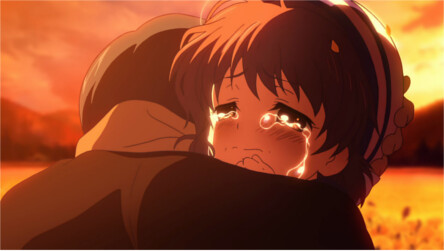If there is something that distinguishes Anime from other mediums is its capacity to provoke strong emotional responses. This is particularly true in the case of sad stories. It’s not uncommon to hear fans recall particularly sad scenes or even recommend a show based on its capacity to trigger crying episodes. But why is Japanese animation so good at this? What makes it such an effective tear-jerking machine?
One of the reasons Anime is capable of making people cry is because of how much the audience ends up caring for their characters. This might have something to do with the way they are designed and animated. Characters like Nayuki from Kanon (Futono, Nakamura, Hatta, Nakayama, & Ishihara, 2006) and Mirai from Beyond the Boundary (Tanaka, Senami, Saito, Nakamura, & Ishidate, 2013), for example, are given delicate features, and cute mannerisms. At first glance this seems to be a superficial choice, but apparently it can make characters more emotionally relevant. Research has shown that people tend to care more for aesthetically pleasant movie characters (Konijn & Hoorn, 2005). Protagonists don’t have to be perfect though. While Nayuki and Mirai are presented as both emotionally and physically strong, they are also clumsy and immature in at least one aspect of their life: Ayu needs an army of alarm clocks in order to wake up early, and Mirai has trouble making enough money to eat properly. Writers probably do this to give them an occasional image of helplessness. An attribute that could elicit a protective attitude in the viewer. Regardless of this, many experts believe that the spectators’ tendency to care for a fictional character has more to do with how they treat other people. Affective Disposition Theory argues that one of the first things an audience does is assess the characters’ moral behavior. If they are good, they wish for their success and fear their misfortune. If they are bad, the opposite happens (a detailed explanation of this process can be found in Zillmann, 2011). Research has found, for example, that people tend to feel more emotionally involved towards a movie character if they show good intentions (Konijn & Hoorn, 2005). Making their protagonists kind isn’t a rule creators follow strictly though. The title character from The Melancholy of Haruhi Suzimiya (Ishihara, 2006), is both attractive and energetic. But her tendency to impose her will onto others and physically abuse them may have ended up alienating some viewers. This changes in the movie, were the story focuses on the efforts of her schoolmate Kyon, trying to restore his timeline with the help of the extremely shy Yuki. Following more sympathetic characters might have allowed viewers to experience a higher level of involvement; which would explain why the film received more positive reviews.
 |
| Kindness seems to go a long way when trying to win the viewer’s heart. |
While the audience disposition towards characters explain why they feel sad, it doesn’t tell us how emotional arousal reaches high enough levels to trigger a crying episode. Excitation Transfer Theory (Zillmann, 1996) states that residual arousal from previous events can combine with those provoked by a current situation, elevating the intensity of the experienced emotion. This makes sense given that certain aspects of the emotional experience, like the feeling of excitement, is maintained by the release of hormones in the bloodstream. A process that can take a couple of minutes to dissipate. The tone of the previous experience also seems important: People tend to feel more involved when watching a depressing scene, if they’ve previously seen another sad clip, instead of a happy one (Zillmann, Mody, & Cantor, 1974). Excitation Transfer would explain why people feel progressively sad with each adversity the brothers from the movie Grave of the Fireflies (Hara & Takahata, 1988) have to experience. But what happens in the case of a TV series? People watching Clannad (Ishihara, 2007) had to wait days between sad events; and even months just for the second season to start. More than enough time for their arousal levels to normalize. In spite of this though, the series is referred to as one of the most emotionally intense dramas ever produced. How is this possible? Well, one explanation could be that watching Tomoya and Nagisa face another misfortune, reminded viewers of all the past difficulties the protagonists had to go through. And, given that recalling unhappy memories is enough to induce people into a sad mood (Westermann, Kordelia, Stahl, & Hesse, 1996), it’s possible that these past scenes may have increased the emotional arousal of viewers. Something that would have made the current event seem even more depressing. If this is true, it could explain why viewers feel more emotionally involved with every additional sad scene, even when they are separated by several days or weeks. Interestingly, it also suggests that, as a series progresses and the depressing moments accumulate, the capacity of a scene to remind viewers of past adversities will have a stronger effect on their emotions. Maybe even more so than actual tragedies. One of the saddest moments in Clannad, for example, isn’t the result of suffering or dead, but of Ushio, standing in a flower field, crying over the loss of a toy Tomoya had just bought her. When he tries to explain that they can buy another one, she calls it: “Dad’s first gift”. A phrase that reminds the audience of all the time together they have lost in the past years.
 |
| Longer dramas might benefit from reminding the viewer of the protagonists’ past misfortunes. |
The repeated exposure to sad scenes eventually puts the viewers in a position where they can barely control themselves. And given that we are naturally biased to express intense sadness through crying, tearing-up becomes almost unavoidable. But just to be sure, Anime directors like to introduce a very effective technique: They make their characters cry. The referred scene in Clannad, for example, is followed by a close-up to Tomoya’s face trying to contain his tears, only to burst up crying. Exposure to this type of content has a predictable effect on people. In an experiment with vignettes, participants reported a higher tendency to feel bad and offer their support to someone in trouble, if they saw them crying (Hendriks, Croon & Vingerhoets, 2008). This result can also be improved by the appropriate soundtrack. A recent study showed that when people listen to sad music, they tend to rate images of individuals crying as more pleasant and kind (Hanser, Mark, Zijlstra, & Vingerhoets, 2015); making them even more deserving of sympathy. Additionally, watching someone tear up has the potential to stimulate any related ideas in the user’s mind; a process known as Spreading Activation (Collins, & Loftus, 1975). It’s possible then that a scene depicting a beloved character’s eyes filling with tears could be promoting the activation of a similar response, in an already highly aroused viewer. In other words, crying scenes would have a dual effect: They push the audience to an unbearable emotional state, while also showing them a way out of it (1).
 |
| Well animated tears could make crying unavoidable during states of high emotional arousal. |
The theories and studies we’ve discussed allow us to understand how Anime manages to provoke such strong emotional responses. But there might be other variables involved. For instance: People could feel either engaged or detached depending on the type of adversity the main characters have to face. Viewers of The Pet Girl of Sakurasou (Ishizuka, 2012) may feel fully invested in the love-triangle, but completely disregard the vocational setbacks the male lead has to go through. It’s also possible that individuals with different age, gender or beliefs would develop opposite attitudes towards the same character. There are still many questions to answer. Sadly, while there is plenty of research in respect to video games and movies; empirical studies that focus specifically on Anime are hard to find. We hope that this type of articles motivates fans and academics to perform their own investigation. Maybe even their own experiments.
Notes:
1. While crying is a natural response, it’s not considered an acceptable behavior in most social contexts. As a result, many people actively try to avoid crying while watching a movie. The effort put into blocking any unwanted behavioral response could work in favor of the emotional experience though. According to an experiment, people who inhibit themselves from crying while watching a sad short, show higher arousal levels than those who allowed themselves to tear up (Labott & Teleha, 1996). This would facilitate the accumulation of emotional arousal. Thus improving the involvement experienced in future scenes.
References:
Collins, A. M., & Loftus, E. F. (1975). A Spreading-Activation Theory of Semantic Processing. In Psychological Review, 82(6), DOI: 10.1037/0033-295X.82.6.407.
Futono, N. (Producer), Nakamura, S. (Producer), Hatta, Y. (Producer), Nakayama, Y. (Producer) & Ishihara, T. (Director). (2006). Kanon [Television series]. Japan: Kyoto Animation.
Hanser, W. E., Mark, R. E., Zijlstra, W. P., & Vingerhoets, Ad. J. J. M. (2015). The effects of background music on the evaluation of crying faces. In Psychology of Music, 43(1). DOI: 10.1177/0305735613498132
Hara, T. (Producer), & Takahata, I. (Director). (1988). Grave of the Fireflies [Motion picture]. Japan: Studio Ghibli.
Hendriks, M. C. P., Croon, M. A., & Vingerhoets, AD J. J. M. (2008). Social reactions to adult crying: The help-soliciting function of tears. In The Journal of Social Psychology, 148(1). DOI: 10.3200/SOCP.148.1.22-42
Ishihara, T. (Director). (2006). Suzumiya Haruhi no Yūutsu [Television series]. Japan: Kyoto Animation.
Ishihara, T. (Director). (2007). Clannad. [Television series]. Japan: Kyoto Animation.
Ishizuka, A. (Director). (2012). Sakura-sō no Pet na Kanojo [Television series]. Japan: J.C. Staff.
Konijn, E. A., & Hoorn, J. F. (2005). Some like it bad: Testing a model for perceiving and experiencing fictional characters. In Media Psychology, 7(2). DOI: 10.1207/S1532785XMEP0702_1
Labott, S. M., & Teleha, M. K. (1996). Weeping propensity and the effects of laboratory expression or inhibition. In Motivation and Emotion, 20(3). DOI: 10.1007/BF02251890
Tanaka, G. (Producer), Senami, R. (Producer), Saito, S. (Producer), Nakamura, S. (Producer) & Ishidate, T. (Director). (2013). Kyōkai no Kanata [Television series]. Japan: Kyoto Animation.
Westermann, R., Kordelia, S., Stahl, G., & Hesse, F. W. (1996). Relative effectiveness and validity of mood induction procedures: A meta-analysis. In European Journal of Social Psychology, 26(4). DOI: 10.1002/(SICI)1099-0992(199607)26:4<557::AID-EJSP769>3.0.CO;2-4
Zillmann, D. (1996). Sequential dependencies in emotional experience and behavior. In Kavanaugh, R.D., Zimmerberg, B., & Fein, S. (Eds), Emotion: Interdisciplinary Perspectives. (pp. 243-272). New Jersey: Erlbaum.
Zillmann, D. (2011). Mechanisms of emotional reactivity to media entertainments. In Doveling, K., von Scheve, C., & Konijn, E. A. (Eds), The Routledge Handbook of Emotions and Mass Media (pp. 101-115). New York: Routledge.
Zillmann, D., Mody, B., & Cantor, J. R. (1974). Empathetic perception of emotional displays in films as a function of hedonic and excitatory state prior to exposure. In Journal of Research in Personality 8(4). DOI: 10.1016/0092-6566(74)90025-7

